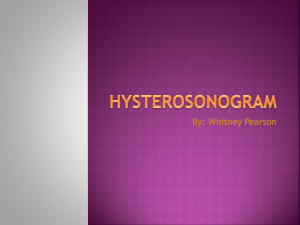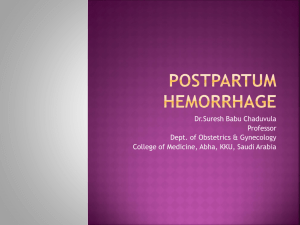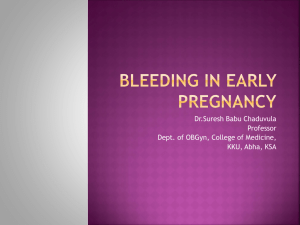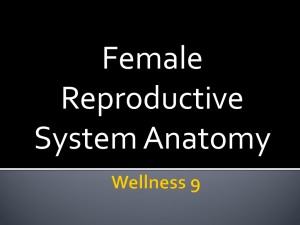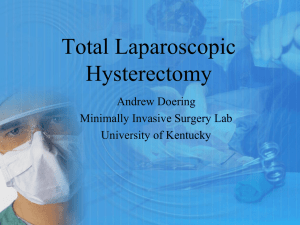Mullerian anomalies - Nagercoil Obstetric and Gynaecological Society
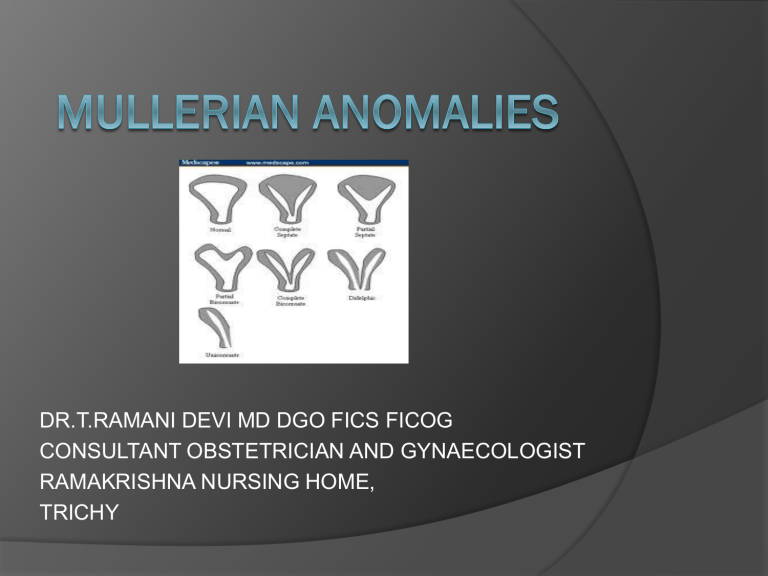
DR.T.RAMANI DEVI MD DGO FICS FICOG
CONSULTANT OBSTETRICIAN AND GYNAECOLOGIST
RAMAKRISHNA NURSING HOME,
TRICHY
INTRODUCTION
MDA are fascinating disorders to obstetricians and gynaecologists
MD forms tubes, uterus, cervix and upper part of vagina
Ranges from agenesis to duplication.
Associated with renal and axial skeletal systems anomalies
Has varying presentation ranging from primary amenorrhea to menstrual disorders, infertility and pregnancy complications like BOH, PTL, Ectopic , etc
MDA has varying treatment from ability to have coitus to conceive and deliver normal babies.
INCIDENCE
Dates back to 16 th century a case utero vaginal agenesis
– Columbo et al (1600)
General population – 0.1-3.5% - Byrene et al
Fertile women – 4.3%
Infertile women – 3.6%
Sterile group - 2.4%
Recurrent Aborters 5 - 13% - Grimbizis et al
ETIOLOGY
Dysregulation occuring in differentiation, migration, fusion and canalisation
Associated with renal anomalies, axial skeletal anomalies and rarely cardiac and auditory anomalies
Probable causes: Intrauterine infection , genetic aberration, Teratogens like DES and
Thalidomide.
GENETICS OF MDA
Sporadic
Familial
Multifactorial
Autosomal dominant
Autosomal recessive
X linked
Variants of GALT (Galactose 1 phosphate uridyl transferase enzyme defect)
Genes Associated :- HOXA 9, 13 & WNT 4
Embryogenesis
Tract of the Reproductive
CLASSIFICATION OF MDA
1979 – Buttram and Gibbons classification
Modified
1988 – American Fertility Society classification
American Fertility Society Classification of Mullerian Anomalies
INCIDENCE OF MDA ACCORDING
TO AFS
Arcuate uterus
Septate uterus
Bicornuate uterus
32.8%
33.6%
20.0%
DES exposed uterus 0.8%
Unicornuate
Uterine didelphys 33%
EFFECT OF MDA UPON REPRODUCTION
Infertility
Endometriosis
Ectopic pregnancy
Recurrent Pregnancy Loss
Prematurity , IUGR , fetal malposition
Uterine dysfunction
Uterine rupture
Increased perinatal morbidity and mortality
DIAGNOSIS OF MDA
Clinical
Hystero salphingogram
Sonosalphingogram
MRI – 100% accuracy
Hystero laparoscopy
Laparotomy or LSCS
Vulvar Abnormalities
Vulval and lower 1/3 rd vagina atresia
Labial Fusion
Most commonly due to congenital adrenal hyperplasia.
Imperforate hymen
Persistence of the fusion between the sinovaginal bulbs at the vestibule
Associated with primary amenorrhea and hematocolpos
Vaginal Abnormalities
Developmental abnormalities of the normal single vagina include:
Vaginal agenesis
Vaginal atresia
Double vagina
Longitudinal vaginal septum
Transverse vaginal septum
Obstetrical significance of vaginal abnormalities
Complete mullerian agenesis – pregnancy is impossible because uterus and vagina is absent
About one third of women with vaginal atresia have associated urological abnormalities
Complete vaginal atresia – precludes intercourse and then pregnancy
In most cases of partial atresia , because of pregnancy-induced tissue softening, obstruction during labor is gradually overcome. interferes with descent
Obstetrical significance of vaginal abnormalities
Complete longitudinal vaginal septum usually does not cause dystocia because half of the vagina through which the fetus descends dilates satisfactorily.
Incomplete septum , however, occasionally interferes with descent.
Cervical Abnormalities
Atresia .
This may be combined with incomplete development of the upper vagina or lower uterus
Double cervix.
Each distinct cervix results from separate müllerian duct maturation.
Both septate and true double cervices are frequently associated with a longitudinal vaginal septum.
Many septate cervices are erroneously classified as double.
Single hemicervix.
This arises from unilateral müllerian maturation.
Septate cervix.
This consists of a single muscular ring partitioned by a septum.
The septum may be confined to the cervix, or more often, it may be the downward continuation of a uterine septum or the upward extension of a vaginal septum.
CLASS I- ROKITANSTY SYNDROME
Primary amenorrhea
Feminine patients
Short vagina
DD: Testicular feminization syndrome
Class I
INVESTIGATIONS
Karyotyping
USG/MRI
Hormone assay
IVP (associated vertebral anomalies can be detected) and renal sonography
Diagnostic Laparoscopy is not routinely done.
TREATMENT
Vaginal Reconstruction
– Vagino plasty : Mac Indoes Vaginoplasty;
Williams vulvovaginoplasty, Vecchietti procedure
Fertility – by surrogacy
Psychological support
Unicornuate Uterus (Class II)
Women with a unicornuate uterus have an increased incidence of infertility, endometriosis, and dysmenorrhea.
Implantation in the normal-sized hemiuterus is associated with increased incidence of:
spontaneous abortion preterm delivery intrauterine fetal demise
UNICORNUATE UTERUS
Unilateral failure of development of MDA
Incidence: 2.5-13%
Types : Unicornuate
Unicornuate with rudimentary horn
-Communicating
-Non communicating
- with endometrium
-without endometrium
Associated Renal anomalies like renal agenesis,
Horseshoe kidney and pelvic kidney44% (In the presence of obstructed horn)
Class II
CLINICAL FEATURES
Haematometra
Endometriosis
Preterm labour – 43%
IUGR
Mal presentation
Ectopic -4.3%
Pregnancy in accessory horn -2%
Rupture uterus
IMAGING MODALITIES IN
UNICORNUATE UTERUS
HSG 3D USG MRI
DIAGNOSIS AND SURGICAL
MANAGEMENT
HSG – non communicating horn cannot be diagnosed
USG – 3D or High Resolution
MRI – banana shaped uterus
Laparoscopy – indicated for excision of rudimentary horn which has endometrium
IVU or renal sonography
Cervical encirclage is mandatory if patient conceives
REPRODUCTIVE OUTCOME IN
UNICORNUATE UTERUS
Live birthrate
Abortion rate
43.7%
35-43%
Preterm delivery 27%
Term delivery 31%
NONCOMMUNICATING RUDIMENTARY UTERINE HORN
* attached fallopian tube ( arrow ) was patent*
UNICORNUATE UTERUS WITH
RUDIMENTARY HORN
Uterine Didelphys (Class III)
This anomaly is distinguished from bicornuate and septate uteri by the presence of complete nonfusion of the cervix and hemiuterine cavity
Except for ectopic and rudimentary horn pregnancies, problems associated with uterine didelphys are similar but less frequent than those seen with unicornuate uterus
Complications may include
- preterm delivery (20%)
- fetal growth restriction (10%)
- breech presentation (43%)
- cesarean delivery rate (82%)
DI DELPHYS
Failure of midline fusion of MD either completely or partially
Incidence: 11%
Types : Total Septum
Partial Septum
Transverse Septum
Class III
CLINICAL FEATURES
Asymptomatic – Failure of tampons to obstruct menstrual flow
Hematometrocolpos if there is
Hematometra
Hematosalpinx obstruction
20% renal anomalies
Endometriosis
Other associated anomalies : bladder exstrophy , congenital VVF, cervical agenesis
IMAGING MODALITIES IN
DIDELPHYS UTERUS
HSG 3DUSG MRI
DIAGNOSIS &SURGICAL MANAGEMENT
Clinical
USG
MRI- 2 widely separated uterine horns, 2 cervices are typical identified. Intercornual angle >60 degree
Laparoscopy
IVP
UTERUS DIDELPHYS
SURGICAL MANAGEMENT
-
With obstruction
Excision of the horn
Non obstruction
Strassmann metroplasty only in selected cases
Cervical encirclage is mandatory if patient conceives
REPRODUCTIVE OUTCOME IN
DI DELPHYS
Term delivery
Ectopic
Abortion
Live birth
20%
2.3%
20%
68%
Preterm delivery 24%
Bicornuate and Septate Uteri
(Classes IV and V)
Marked increase in miscarriages that is likely due to the abundant muscle tissue in the septum
Pregnancy losses in the first 20 weeks were reported by Buttram and Gibbons
70 percent for bicornuate
88 percent for septate uteri
There also is an increased incidence of preterm delivery, abnormal fetal lie, and cesarean delivery.
BICORNUATE UTERUS
Incomplete fusion of MD at uterine fundus level
Incidence - 20%
May be complete - bicornuate bicollis
May be incomplete - bicornuate unicollis
Class IV
ULTRASOUND IMAGING OF SEPTATE
AND BICORNUATE UTERUS
Anna Lev-Toaff, MD , Thomas Jefferson University, PA
Clinical features
Asymptomatic
Abortion 28%
Preterm delivery 25%
Live birth 63%
IMAGING MODALITIES IN
BICORNUATE UTERUS
HSG 3D USG MRI
DIAGNOSIS
To be differentiated from septate uterus
HSG
USG during luteal phase shows 2 endometrial cavities with a deep dimple in the fundus.
MRI – Ideal
Intercornual distance is >105 degrees
Myometrial tissue is seen in bicornuate uterus Vs septum in septate uterus with angle of <75 degree
Laparoscopy
SURGICAL MANAGEMENT
Metroplasty is reserved only in recurrent aborters
Strassmann procedure either by
Laparoscopy or Laparotomy
BICORNUATE UTERUS
BICORNUATE UTERUS WITH
OBSTRUCTION IN ONE HORN
REPRODUCTIVE OUTCOME IN
BICORNUATE UTERUS
Increased incidence in infertile population.
Term pregnancy rate 60%
Live birth 65%
Metroplasty is indicated only when other causes are ruled out.
Acien , 1993
SEPTATE UTERUS
Incomplete resorption of medial septum
Incidence : 33.6%
Types: Complete
Incomplete
DD: Uterus didelphys
Renal tract anomalies are rare
Class V
CLINICAL FEATURES
Dyspareunia
Dysmenorrhoea
Primary or secondary infertility
Poor reproductive performance
IMAGING MODALITIES IN
SEPTATE UTERUS
HSG USG 3DUSG
MRI
SURGICAL MANAGEMENT
-
Hysteroscopic Septal Resection under
Laparoscopic guidance using microscissors, electro cautery, laser,
Versa point
-
-
Stop dissecting
When both cornuae are seen in the same plane
Appearance of vascularity
Move the scope from one side to other
SEPTATE UTERUS
REPRODUCTIVE OUTCOME IN
SEPTATE UTERUS
Spontaneous abortion
Live birth
Term deliveries
Preterm labour
33-75%
62%
51%
10%
Ectopic 2%
Metroplasty increases the incidence of live birth to 82%
Acien , 1993
POST OPERATIVE MANAGEMENT
Estrogens may be used
COMPLICATION
Uterine perforation
Hemorrhage
Cervical incompetence
Residual septum
Class VI
Arcuate Uterus
This malformation is only a mild deviation from the normally developed uterus.
ARCUATE UTERUS
Near complete resorption of the uterovaginal septum.
Small intrauterine indentation shorter than 1cm and located in the fundal region diagnosed by HSG.
Incidence : 32.8%
IMAGING MODALITIES IN
ARCUATE UTERUS
HSG 3D USG MRI
DIAGNOSIS & TREATMENT
HSG
MRI
IVP and renal ultrasound
Hysteroscopy
Resection indicated in poor performers
REPRODUCTIVE OUTCOME IN
ARCUATE UTERUS
Preterm delivery
Live birth
05.1%
66.2%
Ectopics 03.6%
Spontaneous abortion 20.0%
Diethylstilbestrol-Induced
Reproductive Tract Abnormalities
Development of rare vaginal clear cell adenocarcinoma.
Increased risk of developing
cervical intraepithelial neoplasia small-cell cervical carcinoma
vaginal adenosis, non-neoplastic structural abnormalities
Diethylstilbestrol-Induced
Reproductive Tract Abnormalities
Structural Abnormalities:
transverse septa,
circumferential ridges involving the vagina and cervix
cervical collars
smaller uterine cavities
shortened upper uterine segments
T-shaped and irregular
oviduct abnormalities
Diethylstilbestrol-Induced
Reproductive Tract Abnormalities
Their incidences of miscarriage, ectopic pregnancy, and preterm delivery are also increased, especially in women with structural abnormalities
T SHAPED UTERUS
MANAGEMENT OF T SHAPED
UTERUS
Lateral metroplasty
Encerclage is mandatory in the event of pregnancy
CONCLUSION
MDA are not so uncommon
Presents at varying stages of life as primary amenorrhoea , infertility,
Recurrent abortion, preterm labour,
MRI helps in accurate diagnosis
DHL is indicated only when intervention is needed.
Corrective surgery improves pregnancy outcome
-
-
-
DEVELOPMENT OF THE OVARY
The primitive sex cords degenerate & become replaced by vascular fibrous tissue which forms the permanent medulla.
The epithelium of the celomic cavity proliferates & become thicker. It forms columns of cells known as cortical cords .
The cortical cords split into separate follicular cell clusters surrounding germ cells & form together primordial follicles .
-
DEVELOPMENT OF THE DUCTS OF
THE GONADS
2 ducts are formed in male & female embryos: mesonephric (Wolffian ) & paramesonephric (Mullerian) duct.
In male embryo :
Mullerian duct degenerate (except the uppermost part which forms appendix testis & lowermost part which forms prostatic utricle ).
-
-
-
-
-
-
Wolffian duct :
Its upper part becomes markedly convoluted forming the epididymis .
The middle part forms the vas deferens.
The lower part forms a small pouch which forms the seminal vesicle .
The terminal part forms the ejaculatory duct .
(The upper most part of the duct forms appendix epididymis ).
Mesonephric tubules opposite the developing testis forms efferent ducts which become connected to rete testis.
